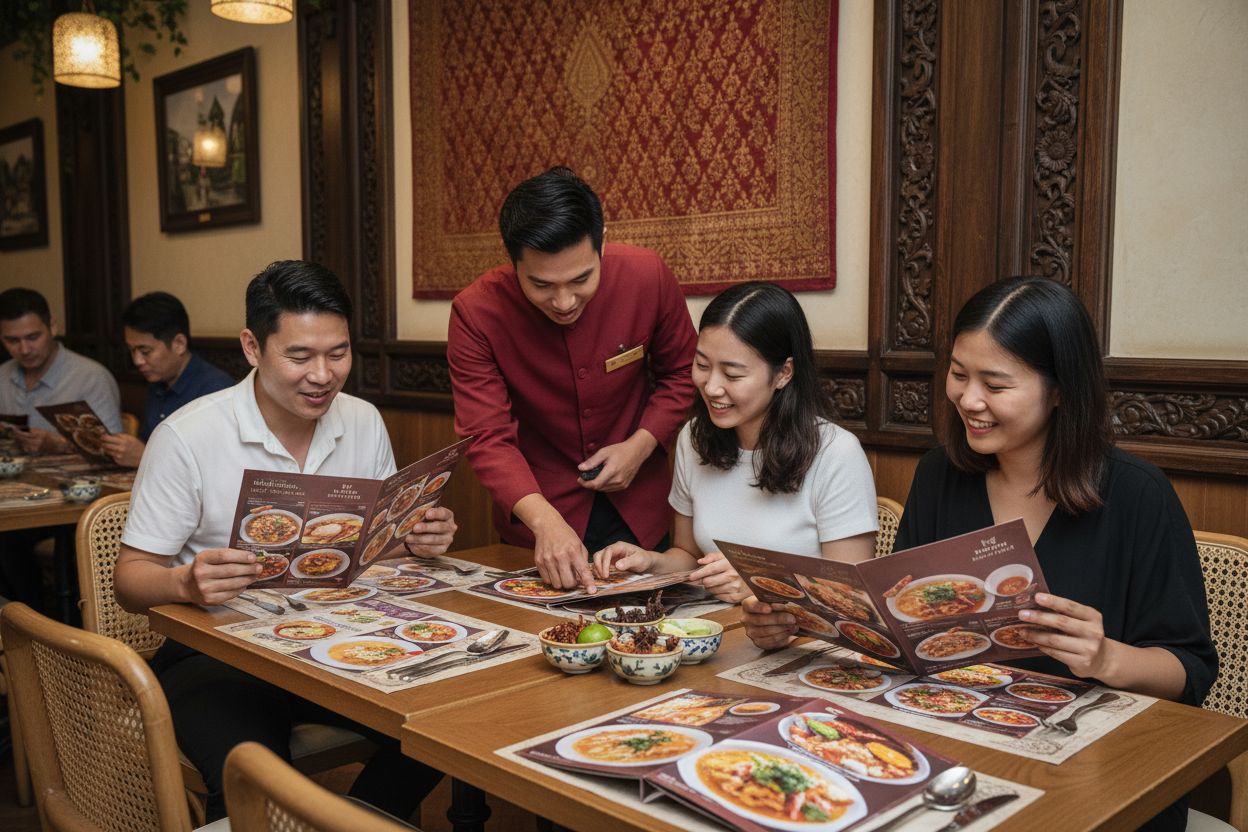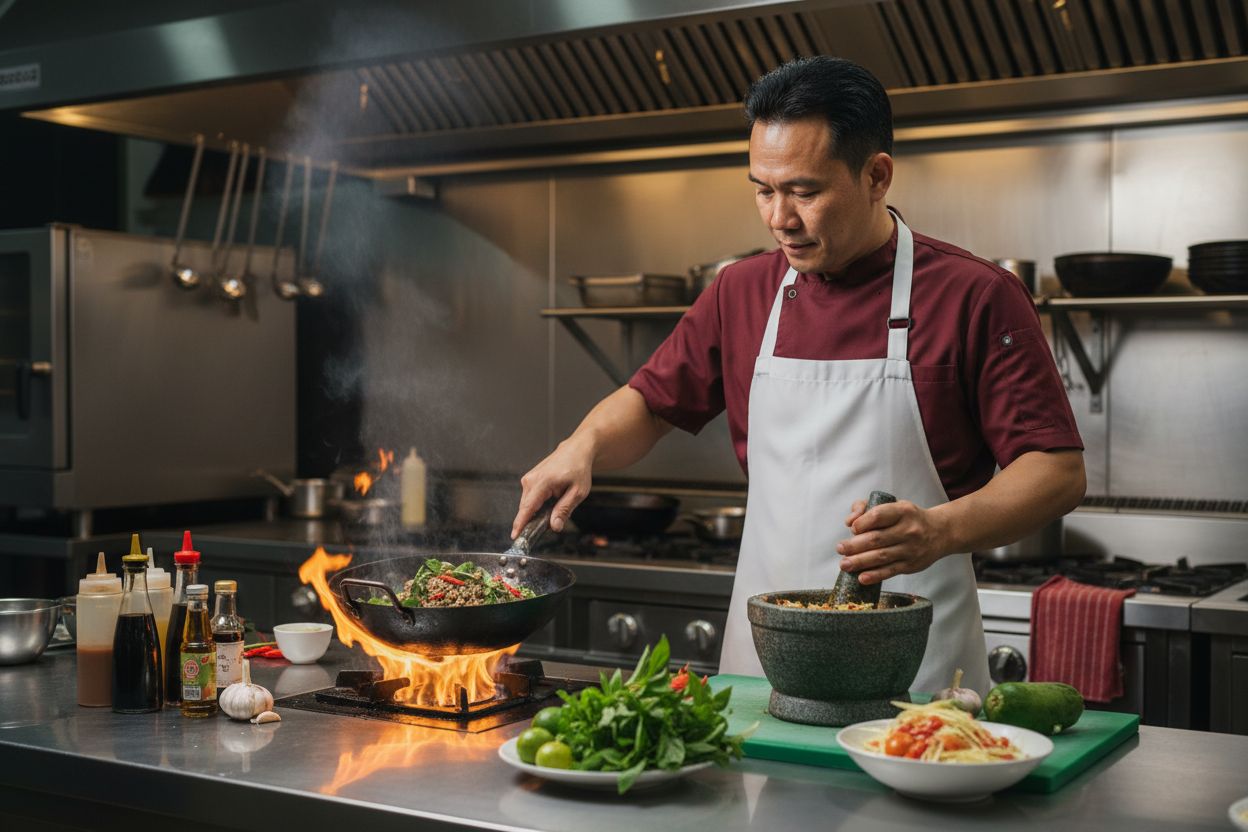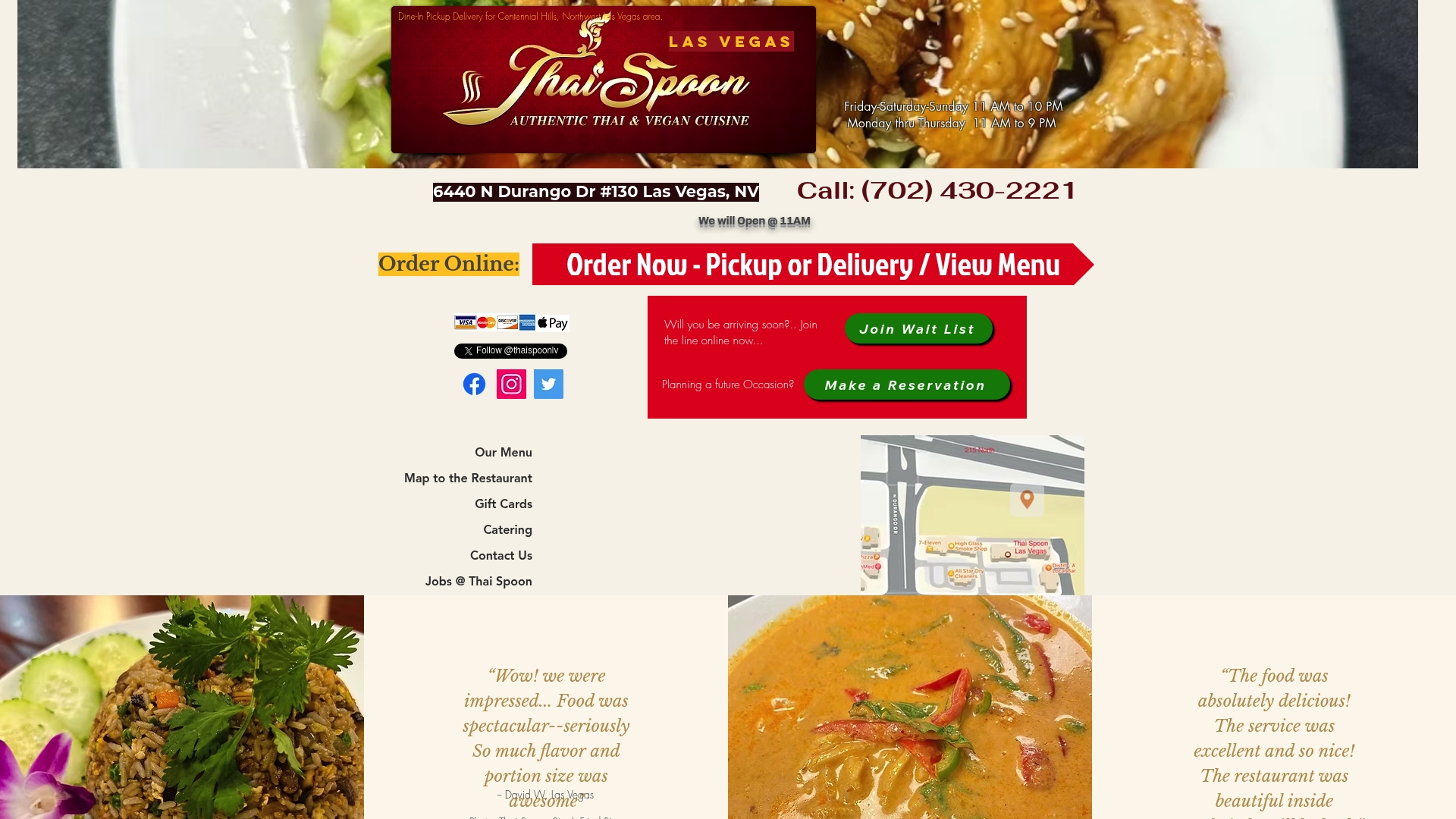How to Enjoy Local Thai Cuisine for Authentic Flavor
- mail469793
- Oct 22
- 8 min read

Did you know there are now over 6,800 Thai restaurants across the United States? This remarkable growth makes it easier than ever to discover the true flavors of Thailand without leaving your city. Authentic Thai dining stretches far beyond the familiar taste of Pad Thai, offering a vibrant world of regional dishes, centuries-old techniques, and bold flavors. With a little guidance, you can uncover the secrets behind genuine Thai cuisine and savor every bite like a seasoned local.
Table of Contents
Quick Summary
Key Point | Explanation |
1. Explore diverse menus for authenticity | Look for traditional dishes that reflect Thailand’s different regions and authentic cooking styles. |
2. Discover iconic Thai signature dishes | Opt for celebrated dishes like Pad Krapow and Som Tam to experience Thailand’s culinary heritage fully. |
3. Customize orders for dietary needs | Most Thai restaurants can adapt dishes for vegetarian, vegan, or gluten-free diets without sacrificing flavor. |
4. Enhance meals with sides and drinks | Incorporate traditional sides and beverages to create a balanced and immersive dining experience. |
5. Provide feedback for restaurant improvement | Share your dining experience with staff to help maintain and enhance the quality of authentic Thai cuisine. |
Step 1: Explore Diverse Menu Offerings
Unveiling the rich world of Thai cuisine begins with understanding the diverse menu offerings that reflect authentic culinary traditions. According to recent research from the Thai SELECT certification program, supported by the Royal Thai Government, there are incredible opportunities to explore genuine Thai menu selections right here in the United States.
Start your culinary journey by scanning the entire menu and looking for traditional dishes that represent different regions of Thailand. You might discover classic options like Pad Thai from central Thailand, spicy Tom Yum soup from the northeast, or rich yellow curry representing southern Thai cooking styles. Finding Authentic Local Thai Food: A Culinary Adventure can help you appreciate these regional nuances.
Look for restaurants that showcase diversity in their menu. As of late 2023, the United States hosts approximately 6,850 Thai restaurants abroad, offering immense variety. Pay attention to dishes that use traditional cooking methods and authentic ingredients. The Thai SELECT symbol is an excellent indicator of quality and authenticity.
Pro Tip: Ask your server about the origin of specific dishes and their unique flavor profiles to enhance your dining experience.
Don’t hesitate to explore fusion options that blend traditional techniques with modern interpretations. Understanding What is Thai Fusion Cuisine can provide additional insights into how chefs creatively reimagine classic recipes.
As you move forward in your Thai cuisine adventure, you will gradually develop a deeper appreciation for the intricate flavors and culinary techniques that make Thai food so extraordinary.
Step 2: Select Signature Thai Dishes
Navigating the world of authentic Thai cuisine means discovering those iconic dishes that truly represent the country’s extraordinary culinary heritage. According to the Tasteatlas Awards 2023/2024, several remarkable Thai dishes have been recognized globally as top culinary experiences.
Start your exploration with legendary signature dishes that showcase Thailand’s incredible flavor complexity. 7 Best Thai Dishes to Try for an Authentic Feast can help guide your selections. Look for internationally celebrated options like Pad Krapow (stir fried basil dish), Khao Soi (northern curry noodle soup), and Massaman Curry which represent different regional cooking styles and ingredients.
Pay special attention to Som tam, a green papaya salad originating in the Isan region. This dish perfectly represents Thai cuisine’s culinary philosophy by balancing four fundamental flavor profiles: sour, spicy, salty, and sweet. Its vibrant combination demonstrates the intricate art of Thai cooking.
Here’s a comparison of signature Thai dishes by region:
Dish Name | Region of Origin | Key Ingredients | Flavor Profile |
Pad Thai | Central Thailand | Rice noodles, tofu/shrimp, peanuts | Sweet, salty, tangy |
Tom Yum Soup | Northeast (Isan) | Lemongrass, lime, chili, shrimp | Sour, spicy, aromatic |
Massaman Curry | Southern Thailand | Coconut milk, potato, spices, beef | Rich, mildly spicy, sweet |
Khao Soi | Northern Thailand | Egg noodles, curry broth, chicken | Creamy, spicy, savory |
Som Tam | Isan (Northeast) | Green papaya, chili, lime, peanuts | Sour, spicy, salty, sweet |
Pro Tip: When selecting signature dishes, ask your server about the specific regional origins to understand the unique cultural background behind each recipe.
Remember that signature Thai dishes are not just about taste but also about understanding the cultural story behind each recipe. Approach your meal as a culinary adventure that connects you with Thailand’s rich gastronomic traditions.

As you continue exploring, you will develop a deeper appreciation for the nuanced flavors and cooking techniques that make Thai cuisine truly extraordinary.
Step 3: Customize Orders for Dietary Needs
Navigating Thai cuisine while accommodating specific dietary requirements doesn’t mean sacrificing authentic flavor. Research from Bangkok University reveals that traditional dishes can be creatively adapted while maintaining their culinary essence.
How to Customize Thai Meals: A Complete Guide offers excellent insights into modifying dishes to suit various dietary preferences. Most Thai restaurants are quite flexible in adjusting recipes for vegetarian, vegan, gluten free, or low carb diets. When ordering, communicate clearly about your specific dietary needs.
For vegetarians and vegans, request dishes prepared without fish sauce or shrimp paste. Many classic recipes like green papaya salad or stir fried vegetables can be easily modified. According to research on Thai traditional food culture, cuisine has successfully adapted to diverse international audiences while preserving its authentic flavor profiles.
Pro Tip: Learn a few key Thai phrases like “Mai Sai Nam Pla” (no fish sauce) or “Mung Sai Nua” (no meat) to help communicate your dietary requirements more effectively.
Pay attention to protein alternatives. Tofu can replace meat in most stir fry and curry dishes, ensuring you still enjoy the rich, complex flavors of traditional Thai cooking. Many restaurants offer plant based protein options that maintain the dish’s original character.
As you continue exploring Thai cuisine, remember that customization is not about compromising authenticity but about making delicious food accessible to everyone.
Step 4: Enhance the Experience With Sides and Drinks
Authentic Thai dining goes far beyond just selecting a main course. According to the Thai SELECT certification, the overall dining quality encompasses sides, condiments, and complementary beverages that transform a simple meal into a truly immersive culinary journey.
What Is Dine-In Thai Experience? Complete Guide provides excellent insights into creating a comprehensive Thai meal. Start by exploring side dishes that complement your main course. Traditional accompaniments like jasmine rice, fresh cucumber salad, and spring rolls can elevate your dining experience and provide balanced flavors.
Pay special attention to condiments and sauces. Thai cuisine offers an array of dipping sauces and chili oils that allow you to customize your meal’s heat and flavor profile. Each sauce tells a story of regional culinary traditions and offers a unique taste experience.
Pro Tip: Request recommendations from your server about which sides and drinks pair best with your chosen main dish to maximize authentic flavor combinations.
Drinks play a crucial role in the Thai dining experience. Consider traditional beverages like Thai iced tea with its distinctive orange color and sweet flavor or fresh coconut water that provides a refreshing counterpoint to spicy dishes. The Thai government’s promotion of authentic cuisine emphasizes that beverages are not just accompaniments but integral parts of the overall dining experience.
As you explore these additional elements, you will discover that sides and drinks are not mere additions but essential components that complete your authentic Thai culinary adventure.
Step 5: Savor Flavors and Share Feedback
The final stage of enjoying authentic Thai cuisine is about truly experiencing and reflecting on the culinary journey you’ve embarked upon. What is a Thai Taste Profile? Understanding Its Flavorful Depth provides excellent insights into how complex and nuanced Thai flavors interact.
When savoring your meal, take time to appreciate the intricate balance of flavors. Notice how sweet, sour, salty, and spicy elements play together in each bite. Pay attention to how different ingredients complement each other and create a harmonious taste experience.
Government initiatives recognize that diner feedback is crucial in maintaining authentic Thai culinary standards. The Thai SELECT certification process relies on consumer experiences to ensure restaurants continue delivering high quality meals. Your observations and comments are more than just personal reflections they contribute to preserving culinary traditions.
Pro Tip: Take mental notes about specific flavor combinations you enjoy most to help you make more informed choices in future Thai dining experiences.
Don’t hesitate to share your thoughts with restaurant staff. Constructive feedback helps restaurants understand what works and how they can improve. Whether you loved a particular dish or have suggestions for enhancement your input matters.
Remember that enjoying Thai cuisine is about more than just eating its about connecting with a rich cultural culinary experience that tells a story through every carefully prepared bite.
Discover Authentic Thai Flavors Close to Home
Finding genuine Thai cuisine that captures the true essence of regional dishes while offering customization for dietary needs can be challenging. The article highlights key pain points like exploring diverse menus, selecting authentic signature dishes, and customizing orders without losing flavor. If you are craving the vibrant balance of flavors that Thai cooking is known for, you need a local spot that understands these nuances and makes your experience seamless.
At Thai Spoon Las Vegas, we bring authentic Thai cuisine to the northwest Las Vegas area with carefully crafted dishes like Pad Thai, Yellow Curry, and vegan or gluten-free options that honor traditional flavor profiles. Whether you prefer to dine in, pick up your meal, or enjoy delivery, our menu is designed to immerse you in the rich cultural journey described in the article, making every bite a celebration of Thai culinary heritage.
Ready to experience Thailand’s diverse tastes without leaving Nevada?

Explore our full menu and order online today at Thai Spoon Las Vegas. From special lunch deals to happy hour specials and catering for your next gathering, we make authentic Thai accessible and delicious. Don’t wait to savor the bold, balanced flavors you’ve been learning about.

Visit us now and discover your new favorite Thai dining destination.
Frequently Asked Questions
How can I explore diverse menu offerings at a Thai restaurant?
To explore diverse menu offerings, start by scanning the entire menu for traditional dishes that reflect various regional cuisines of Thailand. Look for classic options like Pad Thai or Tom Yum soup to experience authentic flavors.
What are some signature Thai dishes I should try for an authentic flavor?
You should try signature dishes like Pad Krapow and Khao Soi, as they showcase Thailand’s unique culinary heritage. Ask your server for recommendations on regional specialties to deepen your understanding of each dish.
How can I customize my Thai meal to accommodate dietary needs?
To customize your Thai meal for dietary needs, communicate clearly with your server about your preferences, such as requesting vegetarian or gluten-free options. For example, asking for dishes without fish sauce can help you enjoy traditional flavors within your dietary restrictions.
What sides and drinks complement my main Thai dish?
To enhance your Thai dining experience, consider choosing traditional sides like jasmine rice or fresh spring rolls that pair well with your main dish. Ask your server for recommendations based on your selected meal to complete your experience with complementary drinks.
How should I savor the flavors of my Thai meal?
To savor the flavors, take your time to appreciate the balance of sweet, sour, salty, and spicy elements in each bite. Note the specific combinations you enjoy, which can inform your future dining choices.
How can I provide feedback on my Thai dining experience?
To provide feedback, share your thoughts with restaurant staff about what you enjoyed or any areas for improvement. Constructing your feedback can help maintain high culinary standards and improve the overall dining experience.
Recommended











Comments